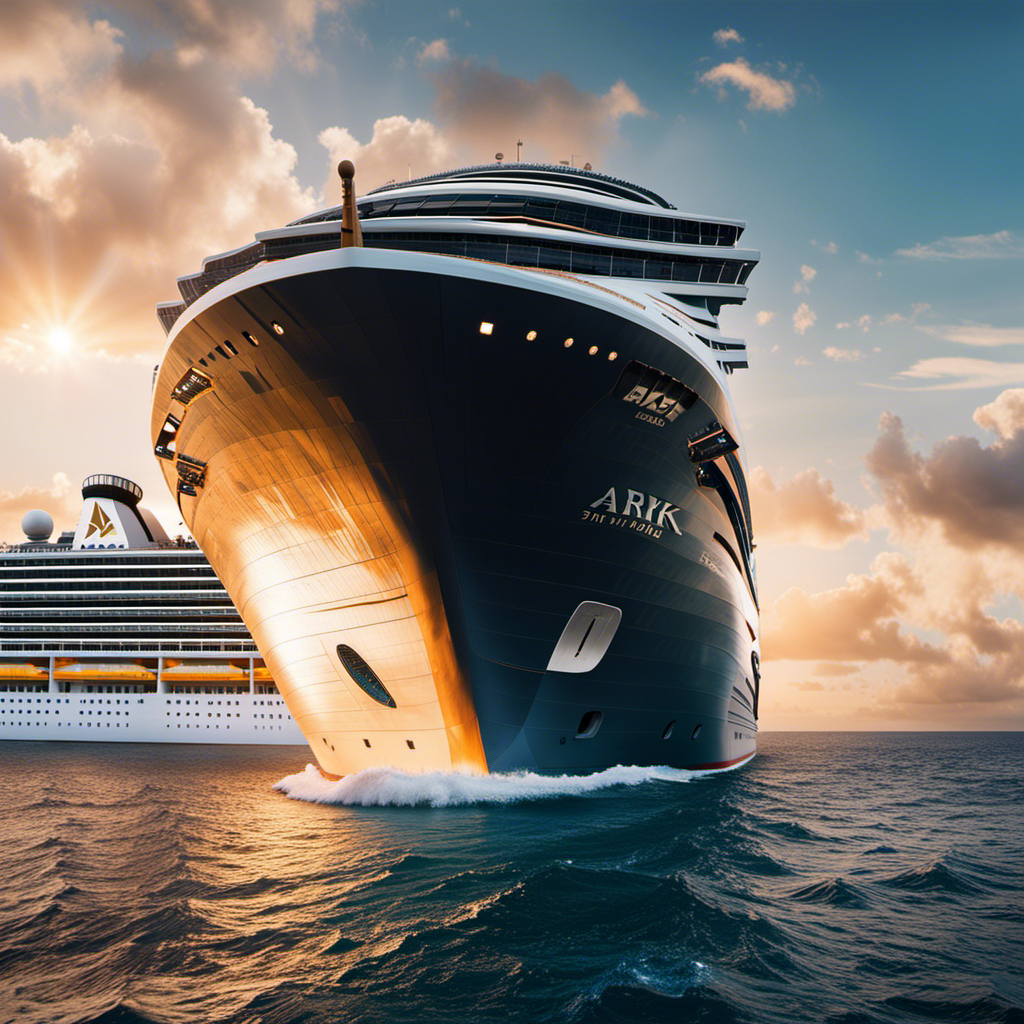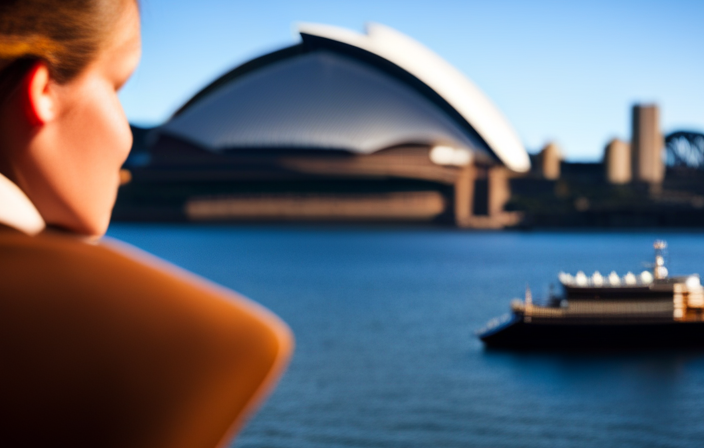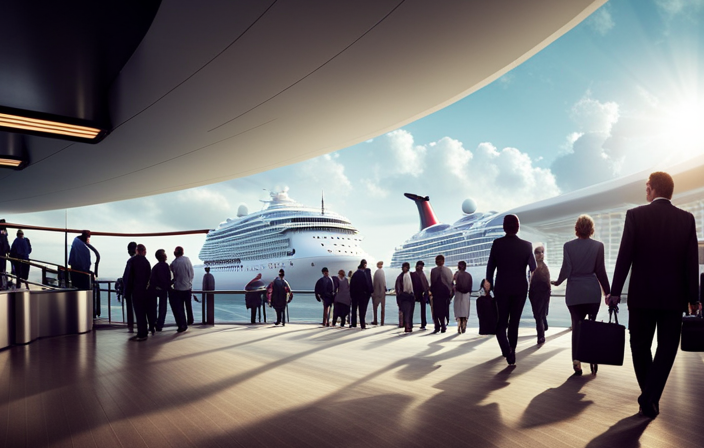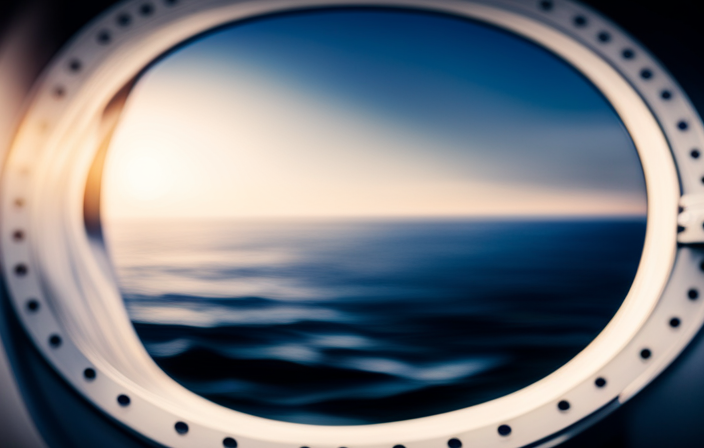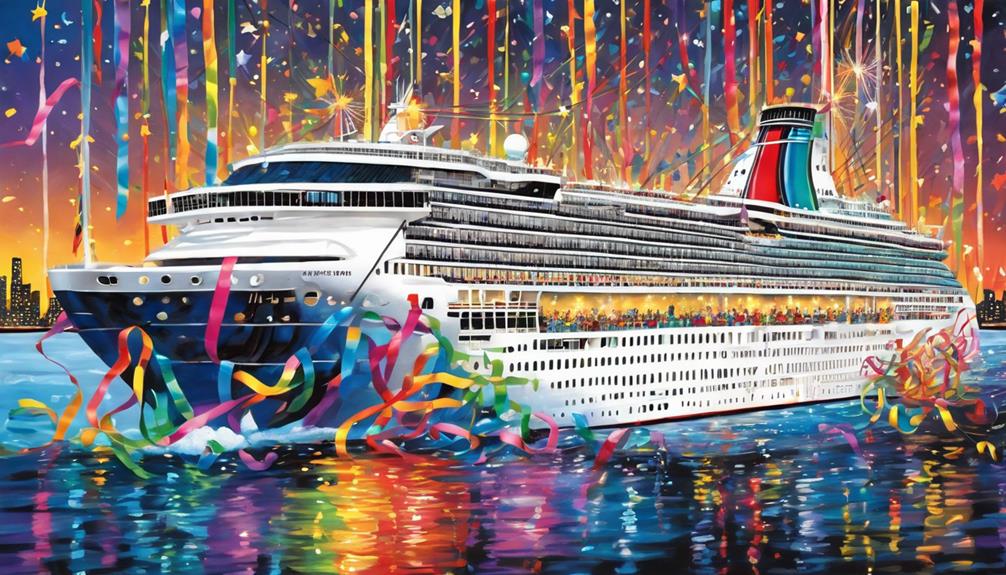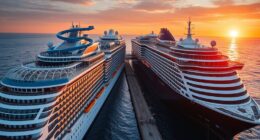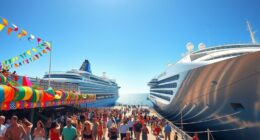I’ve always been fascinated by the story of Noah’s Ark. It’s incredible to think about the huge size and measurements required to house such a wide variety of animals on the Ark. This interest prompted me to investigate how the dimensions of the Ark compare to today’s cruise ships.
In this article, we will delve into the dimensions of the Ark and explore how it measures up to a typical cruise ship. Prepare to be amazed as we dive into the details and uncover the intriguing similarities and differences between these two colossal structures.
Key Takeaways
- The ark’s dimensions were approximately 450 feet long, 75 feet wide, and 45 feet tall, while modern cruise ships can reach up to 1,188 feet in length and over 200 feet in height.
- The ark was constructed with gopher wood, believed to be a type of cypress, while cruise ships are built with steel, aluminum, and advanced materials.
- The ark had a limited capacity, designed to rescue Noah, his family, and a pair of every animal species, while modern cruise ships can accommodate thousands of passengers and crew.
- The ark’s design focused on housing animals and storage, while cruise ships are designed for passenger transportation and luxury.
Dimensions of the Ark
The dimensions of the Ark were significantly smaller compared to a modern cruise ship. Constructed of gopher wood, the Ark measured approximately 300 cubits in length, 50 cubits in width, and 30 cubits in height. This translates to about 450 feet long, 75 feet wide, and 45 feet high.
The construction materials used in the Ark were carefully chosen to ensure its durability and strength. The use of gopher wood, a type of tree that is believed to have been strong and resistant to rotting, contributed to the Ark’s ability to withstand the great flood.
Inside the Ark, animal housing was carefully planned. Various compartments were created to provide adequate space and shelter for the animals, as well as storage for food and supplies.
Transitioning to the subsequent section about the size of a modern cruise ship, it is evident that the Ark pales in comparison.
Size of a Modern Cruise Ship
Imagine yourself standing next to a massive vessel that can carry thousands of people and has multiple decks for entertainment and accommodations. Modern cruise ships are known for their sheer size and luxurious amenities. Here are four key features that highlight the size and grandeur of these floating cities:
- Length: Cruise ships can measure up to 1,188 feet long, dwarfing many other types of ships.
- Height: With towering structures and multiple decks, cruise ships can reach heights of up to 236 feet above the waterline.
- Weight: These ships can weigh around 225,000 tons, requiring powerful engines and advanced technology to navigate the seas.
- Passenger Capacity: Cruise ships can accommodate up to 6,000 passengers, providing a wide range of amenities and activities to keep everyone entertained.
Maneuverability challenges and passenger amenities are crucial considerations when designing these colossal vessels. From state-of-the-art propulsion systems to luxurious accommodations, cruise ships strive to provide a seamless and enjoyable experience for their guests.
As we compare the lengths of the ark and a modern cruise ship, we can truly appreciate the engineering feats achieved in both eras.
Comparing Lengths: Ark Vs Cruise Ship
Step back and consider the impressive difference in size between the ark and a modern cruise ship. When it comes to construction materials and engineering techniques, the ark was truly a marvel of its time.
Built thousands of years ago, it was constructed using wood, specifically gopher wood, which is believed to be a type of cypress. The engineering techniques employed in building the ark were innovative for its time, utilizing a combination of wooden beams, pegs, and strong joints to ensure its structural integrity.
In contrast, modern cruise ships are constructed using steel, aluminum, and other advanced materials, with sophisticated engineering methods to withstand the harsh conditions of the open sea. This stark contrast in construction materials and engineering techniques highlights the vast technological advancements that have taken place over the centuries.
Transitioning into the subsequent section about the width comparison between the ark and a cruise ship, it is important to note that the differences in size are not limited to just length.
Width Comparison: Ark Vs Cruise Ship
Take a moment to consider the sheer magnitude of the difference in width between the ark and a modern cruise ship. The ark, with its colossal dimensions, posed significant maneuverability challenges compared to the sleek and technologically advanced cruise ships of today. Here are three architectural differences that highlight the vast contrast in width between the two:
-
The ark’s width was around 50 cubits (approximately 75 feet), while the width of a typical modern cruise ship can range from 100 to 150 feet.
-
The ark’s width was not uniform throughout its length, as it was designed with three decks. In contrast, cruise ships have a consistent width throughout their entire length.
-
The ark’s width-to-length ratio was much larger than that of a cruise ship, leading to a less streamlined and more unwieldy design.
Considering these differences, it becomes evident that the ark’s width presented unique challenges in terms of maneuverability and architectural design.
Transitioning into the subsequent section about the height comparison between the ark and a cruise ship…
Height Comparison: Ark Vs Cruise Ship
The height of a typical modern cruise ship is significantly greater than that of the ark. While the exact height of the ark is not known, estimates suggest that it was around 30 cubits or approximately 45 feet tall. In comparison, modern cruise ships can reach heights of over 200 feet or more.
This significant difference in height poses maneuverability challenges for cruise ships, especially in narrow waterways or when passing under bridges. The higher center of gravity on cruise ships also affects their stability, making them more susceptible to strong winds and rough seas.
However, advancements in ship design and technology have allowed cruise ships to overcome these challenges and ensure a safe and comfortable experience for passengers.
Transitioning into the next section, let’s explore the total capacity of the ark compared to a modern cruise ship.
Total Capacity: Ark Vs Cruise Ship
Imagine how many people a modern cruise ship can accommodate compared to the ark. The capacity comparison between these two vessels is staggering and holds great historical significance.
While a typical cruise ship can carry thousands of passengers and crew members, the ark had a much more limited capacity. According to biblical accounts, the ark was designed to rescue and house Noah, his family, and a pair of every animal species on Earth. This would have required a tremendous amount of space, but still nowhere near the capacity of a modern cruise ship. The ark’s capacity was likely limited to a few hundred people and animals, making it a remarkable feat of engineering for its time.
Transitioning into the next section about the structural differences between the ark and a cruise ship, we can explore the contrasting designs and functionalities of these two vessels.
Structural Differences: Ark Vs Cruise Ship
The structural differences between an ark and a cruise ship are quite evident. While both serve the purpose of transporting passengers, they differ greatly in size, design, and amenities. To illustrate these differences, let’s compare the dimensions and features of an average ark and a modern cruise ship.
| Ark | Cruise Ship | |
|---|---|---|
| Length | 300 cubits | 300-1,200 feet |
| Width | 50 cubits | 100-200 feet |
| Height | 30 cubits | 10-20 decks |
| Passenger Capacity | Unknown | 2,000-6,000+ |
| Amenities | Basic living quarters | Pools, theaters, casinos |
When considering the cost comparison, it is clear that cruise ships are far more expensive to construct and maintain, given their larger size and luxurious amenities. Passenger amenities are also significantly more abundant on cruise ships, offering a wide range of entertainment options. These differences in structure and offerings present unique navigational challenges for both arks and cruise ships, which will be explored in the next section.
Navigational Challenges: Ark Vs Cruise Ship
When comparing the size and maneuverability of the ark to a modern cruise ship, it is clear that there are significant differences. The ark, as described in the biblical account, was an enormous vessel capable of accommodating a large number of animals and supplies.
However, its size and lack of advanced technology would have made it much less maneuverable than a modern cruise ship. Furthermore, when considering the navigational challenges faced by the ark, it’s important to take into account the weather and sea conditions of the time.
The ark would have had to navigate through potentially treacherous waters, dealing with storms, rough seas, and other adverse weather conditions without the aid of modern navigational tools. These factors highlight the stark contrast between the ark and a modern cruise ship in terms of size, maneuverability, and the challenges they would face in navigating through various weather and sea conditions.
Size and Maneuverability
To better understand the size and maneuverability of the ark, picture yourself trying to navigate a massive vessel like a cruise ship through rough waters. The ark, being even larger than a cruise ship, would have faced numerous challenges when it came to maneuverability.
Here are some of the key factors that would have made maneuvering the ark difficult:
-
Size of the ark: With its enormous dimensions (300 cubits long, 50 cubits wide, and 30 cubits high), the ark would have been unwieldy and slow to respond to changes in direction.
-
Lack of propulsion: Unlike modern ships, the ark did not have engines or sails to help with maneuvering. It relied solely on the power of the currents and winds.
-
Limited control: Steering the ark would have been a challenge, as it lacked modern navigation systems and had to rely on basic methods like ropes and rudders.
-
Shallow draft: The ark had a shallow draft, which means it sat high in the water. This would have made it susceptible to being pushed off course by strong winds and currents.
-
Historical significance: The ark’s ability to navigate and survive the floodwaters holds great historical and religious significance.
Considering these maneuverability challenges, it is clear that the ark would have faced significant obstacles in navigating through turbulent waters.
Now let’s explore the impact of weather and sea conditions on the ark’s journey.
Weather and Sea Conditions
Navigating through rough waters would have been challenging for the ark due to its enormous size and lack of modern navigation systems. The ship stability and impact of storms would have been major concerns for Noah and his family. The ark, measuring approximately 450 feet long, 75 feet wide, and 45 feet high, was a massive structure that would have faced significant challenges in maintaining stability during storms. To better understand the potential impact of storms on the ark, let’s compare it to a modern cruise ship.
| Ark | Cruise Ship | |
|---|---|---|
| Length | Approximately 450 feet | 1,100 – 1,200 feet |
| Width | Approximately 75 feet | 125 – 150 feet |
| Height | Approximately 45 feet | 200 – 250 feet |
| Passengers | Noah, his family, and animals | Thousands of passengers |
As we can see, the ark was significantly smaller and lacked the advanced technology and engineering of modern cruise ships. This would have made it more susceptible to the impact of storms, making the navigation and stability of the ark an even greater challenge during adverse weather conditions.
Frequently Asked Questions
How Long Did It Take to Build the Ark Compared to a Modern Cruise Ship?
It took significantly longer to build the ark compared to a modern cruise ship. The ark was constructed over a period of several decades, while a cruise ship can be built in a matter of years using advanced construction materials.
What Materials Were Used to Construct the Ark, and How Do They Compare to Those Used in Modern Cruise Ships?
When comparing the construction materials of the ark to those used in modern cruise ships, there are significant differences in terms of strength, durability, and stability. The ark was built using wood, while cruise ships utilize advanced materials like steel and fiberglass. These structural differences contribute to the varying levels of stability between the two.
What Were the Navigational Challenges Faced by the Ark Compared to Those Faced by a Modern Cruise Ship?
Navigational challenges were faced by the ark, such as lack of modern technology and limited maneuverability. Construction time was also a factor, as it took years to build the ark compared to the shorter time required for a cruise ship.
How Many Decks Did the Ark Have, and How Does That Compare to the Number of Decks on a Modern Cruise Ship?
The number of decks on the ark is unknown, but it was designed to save animals, not accommodate passengers. In contrast, modern cruise ships have multiple decks to cater to a large number of passengers and provide various amenities.
What Were the Major Differences in the Structural Design and Stability Between the Ark and a Modern Cruise Ship?
In comparing the structural design and stability of the ark to a modern cruise ship, it is important to consider the major differences. The ark was built for survival, while a cruise ship prioritizes comfort and luxury. These contrasting objectives result in significant variations in size, materials, and construction techniques. Additionally, the ark lacked the advanced technology and engineering innovations found in modern cruise ships, which greatly impact stability and safety at sea.
Conclusion
In conclusion, the dimensions of the ark were truly remarkable, considering the time it was built. However, when compared to modern cruise ships, the ark pales in comparison.
For example, the length of the ark was approximately 300 cubits, while the largest cruise ship today measures around 1,188 feet in length. This staggering difference highlights the advancements in shipbuilding and engineering over the centuries.
It is intriguing to think about how far we have come in terms of maritime technology and the capabilities of these enormous vessels.

